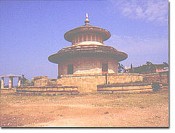Kalidasa

Kālidāsa (Devanāgarī: कालिदास "servant of Kali") was a renowned Classical Sanskrit writer, widely regarded as the greatest poet and dramatist in the Sanskrit language. His floruit cannot be dated with precision, but most likely falls within the Gupta period, probably in the 4th or 5th century or 6th century. His place in Sanskrit literature is akin to that of Shakespeare in English.[1] His plays and poetry are primarily based on Hindu mythology and philosophy. Nothing apart from his works is known with certainty about the life of Kālidāsa, such as his period or where he lived. Little is known about Kalidasa's life. According to legend, the poet was known for his beauty which brought him to the attention of a princess who married him. However, as legend has it, Kalidasa had grown up without much education, and the princess was ashamed of his ignorance and coarseness. A devoted worshipper of the goddess Kali (his name means literally Kali's servant), Kalidasa is said to have called upon his goddess for help when he was going to commit suicide in a pond after he was humiliated by his wife, and was rewarded with a sudden and extraordinary gift of wit. He is then said to have become the most brilliant of the "nine gems" at the court of the fabulous king Vikramaditya of Ujjain. Legend also has it that he was murdered by a courtesan in Sri Lanka during the reign of Kumaradasa. A terminus ante quem is given by the Aihole Prashasti of 634 AD, which has a reference to his skills; and a terminus post quem can be presumed from his play Mālavikāgnimitra in as much as the hero, King Agnimitra of the Shunga dynasty, assumed the throne of Magadha in 152 BC. The linguistic features of the Prakrit dialects used by some of the minor characters in his plays have been adduced to suggest that he could not have lived before the 3rd century AD. There has been great ambiguity regarding the exact date of Kalidasa but in 1986, Sanskrit scholar Dr. Ramchandra Tiwari of Bhopal claims to have conducted a thorough research on Kalidasa and after analysing 627 archaeological evidences which included 104 sculptures, 30 pictures and 493 scriptural words determined that Kalidasa lived in the period 370-450AD . One of the archaeological proofs was provided by Padmanabh Sheshshayi Lakshminarayan.[2] In his works, Kālidāsa did not mention any king as his patron, or any dynasty other than the Shunga dynasty, but several historians have credited the traditional account of Kālidāsa as one of the "nine gems" at the court of a king named Vikramāditya. There were, however, several kings in ancient India by that name. One among them was the Tuar Rajput emperor Vikramaditya of Ujjain who founded the Vikrama Samvat following his victory over the Sakas in 56 BCE[3]. Scholars have noted other possible associations with the Gupta dynasty, which would put his date in the range of 300-470 AD: Scholars have speculated that Kālidāsa may have lived either near the Himalayas or in the vicinity of Ujjain. The two speculations are based respectively on Kālidāsa's detailed description of the Himalayas in his Kumārasambhava and the display of his love for Ujjain in Meghadūta. Kālidāsa wrote three plays. Among them, Abhijñānaśākuntalam ("Of Shakuntala recognised by a token") is generally regarded as a masterpiece. It was among the first Sanskrit works to be translated into English, and has since been translated into many languages [4]. Kālidāsa is the author of two epic poems, Raghuvamsa ("Dynasty of Raghu") and Kumārasambhava ("Birth of Kumāra"). Among his lyric poems are Meghadūta ("Cloud Messenger") and Ṛtusaṃhāra ("The Exposition on the Seasons"). Kālidāsa's poetry is celebrated for its beautiful imagery and use of similes. The following are some specimen verses from his works. As Parvati is meditating, the first rain drops of the monsoon fall on her: valīṣu tasyāḥ skhalitāḥ prapedire cireṇa nābhiṃ prathamodabindavaḥ ॥ King Aja grieves over the death of Indumati and is consoled by a hermit: drumasānumatāṃ kim antaraṃ yadi vāyau dvitaye 'pi te calāḥ ॥ O king! you are the finest among men with self-control. It is not fit of you to be struck by sorrow like the ordinary folk. If a great wind can move a tree and a mountain equally, how is the mountain better? Dushyanta describes Shakuntala to his friend: At Indumati's swayamvara, princes are downcast as she passes by without showing interest:[5] As Indumati walked past each king and went to the next king (in a ceremony of choosing her husband), the king's face would turn bright and then pale. It was like watching a line of houses in the night as a dazzling lamp passed by. Dasharatha's hunt: Dasaratha saw many beasts as he was hunting. Although he saw a peacock fly very close to his chariot, he did not shoot his arrow. For, as the peacock spread its tail feathers before him, it reminded him of his wife's hair adorned with flowers of different kinds and how it would become disarranged during their lovemaking. Rama's coronation is announced: The news of the beloved Rama being crowned as king gave special joy to every citizen, like a stream that wets every tree in a garden. The loveliest verses of Kalidasa, are found in Meghadūta, which are given as follows - - Meaning: when I try to draw your picture and show in it that I am bowing at your feet, with a 'kawa-a type of chalk', on the rock; due to emotional outbreak, my eyes get wet. The 'Krutāntā or Yama' himself does not wish to have our meet in the picture itself... Similarly the beauty-symbols of a woman has been so beautifully shown in a verse of Kalidasa's Meghadūta as follows - -Meaning: This verse is as such that its meaning can only be understood word-wise, given as follows - Many oriental and occidental scholars have written commentaries on the works of Kālidāsa. Among the most studied commentaries are those by Kolāchala Mallinātha Suri, which were written in the 15th century during the reign of the Vijayanagar king, Deva Rāya II. The earliest surviving commentaries appear to be those of the tenth-century Kashmirian scholar Vallabhadeva.[6] Eminent Sanskrit poets like Bāṇabhaṭṭa, Jayadeva and Rajasekhara have lavished praise on Kālidāsa in their tributes. A well-known Sanskrit verse ("Upamā Kālidāsasya…") praises his skill at upamā, or similes. Anandavardhana, a highly revered critic, considered Kālidāsa to be one of the greatest Sanskrit poets ever. Of the hundreds of pre-modern Sanskrit commentaries on Kālidāsa's works, only a fraction have been contemporarily published. Such commentaries show signs of Kālidāsa's poetry being changed from its original state through centuries of manual copying, and possibly through competing oral traditions which ran alongside the written tradition. Kālidāsa's Abhijñānaśākuntalam was one of the first works of Indian literature to become known in Europe. It was first translated to English and then from English to Germany, where it was received with wonder and fascination by a group of eminent poets, which included Herder and Goethe.[7] Kālidāsa's work continued to evoke inspiration among the artistic circles of Europe during the late 1800s and early 1900s, as evidenced by Camille Claudel's sculpture Shakuntala. Koodiyattam artist and Natya shastra scholar Māni Mādhava Chākyār (1899-1990) choreographed and performed popular Kālidāsā plays including Abhijñānaśākuntala, Vikramorvaśīya and Mālavikāgnimitra. Mohan Rakesh's play in Hindi, Āshad ka ek din (1958), tries to capture the conflict between the ethereal beauty repeatedly portrayed in Kālidāsa's works and the harsh realities of his time. V. Shantaram made the Hindi movie Stree (1961) based on Kālidāsa's Shakuntala. Surendra Verma's Hindi play Athavan Sarga, published in 1976, is based on the legend that Kālidāsa could not complete his epic Kumārasambhava because he was cursed by the goddess Pārvati, for obscene descriptions of her conjugal life with Lord Shiva in the eighth canto. The play depicts Kālidāsa as a court poet of Chandragupta who faces a trial on the insistence of a priest and some other moralists of his time. Asti Kashchid Vagarthiyam is a five act Sanskrit play written by Krishna Kumar in 1984. The story is a variation of the popular legend that Kālidāsa was mentally challenged at one time and that his wife was responsible for his transformation. Kālidāsā, a mentally challenged woodcutter, is married to Vidyottamā, a learned princess, through a conspiracy. On discovering that she has been tricked, Vidyottamā banishes Kālidāsa asking him to acquire scholarship and fame if he desires to continue their relationship. She further stipulates that on his return he will have to answer the question, Asti Kashchid Vāgārthah" ("Is there anything special in expression?"), to her satisfaction. In due course, Kālidāsa attains knowledge and fame as a poet. Kālidāsa begins Kumārsambhava, Raghuvansha and Meghaduta with the words Asti ("there is"), Kashchit ("something") and Vāk ("speech.") Dr. Bishnupada Bhattacharya's "Kalidas o Robindronath" is a comparative study of Kalidasa and the Bengali poet Rabindranath Tagore The Kannada films Kaviratna Kalidasa, featuring Rajkumar, and Mahakavi Kalidasa were based on the Kālidāsa legendary life and work.
do you like this author?
What readers are saying
What do you think? Write your own comment on this book!
write a commentWhat readers are saying
What do you think? Write your own comment on this author!
write a commentBook list

Prabodhatschandrodaja; oder, Der Erkenntnissmondaufgang, philosophisches Drama von Krischnamisra. Meghaduta; oder, Der Wolkenbote, lyrisches Gedicht von Kalidasa. Beides metrisch übersetzt von Bernhard Hirzel
Series:
Unknown
Year:
Unknown
Raiting:
4/5
26
Show more
add to favoritesadd In favorites

Sakountalâ, d'apres l'oeuvre indienne de Kalidasa
Series:
Unknown
Year:
Unknown
Raiting:
3/5
26
Show more
add to favoritesadd In favorites

Exhaustive Notes on the Meghaduta: Comprising Various Readings, the Text with the Commentary of ...
Series:
Unknown
Year:
Unknown
Raiting:
3/5
Book digitized by Google from the library of Harvard University and uploaded to the Internet Archive by user tpb.
Show more
add to favoritesadd In favorites

Agnimitra et Mālavikā; comédie en cinq actes
Series:
Unknown
Year:
Unknown
Raiting:
4/5
Book digitized by Google from the library of Harvard University and uploaded to the Internet Archive by user tpb.
Show more
add to favoritesadd In favorites

Sakuntala; or, The fatal ring: a drama; to which is added Meghaduta; or, The cloud messenger; The Bhagavad-gita; or, Sacred song
Series:
Unknown
Year:
Unknown
Raiting:
4.5/5
Show more
add to favoritesadd In favorites

The Vicramorvaśîya with the Commentary Styled 'Arthaprakásiká
Series:
Unknown
Year:
Unknown
Raiting:
4.5/5
Book digitized by Google from the library of Harvard University and uploaded to the Internet Archive by user tpb.
Show more
add to favoritesadd In favorites

Meghaduta with the commentary of Daksinavartanatha
Series:
Unknown
Year:
Unknown
Raiting:
5/5
Trivandrum Sanskrit Series edition
Show more
add to favoritesadd In favorites

Kalidasa translations of Shakuntala, and other works
Series:
Unknown
Year:
Unknown
Raiting:
5/5
Book digitized by Google from the library of the New York Public Library and uploaded to the Internet Archive by user tpb. Bibliography : p. xxii Introduction: Kalidasa--his life and writings.--Shakuntala.--The story of Shakuntala.--The two minor dramas: I. Malavika and Agnimitra. II. Urvashi.--The dynasty of Raghu.--The birth of the war-god.--The cloud-messenger.--The seasons
Show more
add to favoritesadd In favorites

The Mâlavikâgnimitra: a Sanskrit play
Series:
Unknown
Year:
Unknown
Raiting:
3.5/5
Book digitized by Google from the library of the University of California and uploaded to the Internet Archive by user tpb.
Show more
add to favoritesadd In favorites

The Vikramorvas'īya with Commentary (Prakâs'ikâ) of Ranganâtha
Series:
Unknown
Year:
Unknown
Raiting:
4.5/5
Book digitized by Google from the library of Harvard University and uploaded to the Internet Archive by user tpb.
Show more
add to favoritesadd In favorites

The Málavikágnimitra: A Sanskrit Play
Series:
Unknown
Year:
Unknown
Raiting:
4/5
Book digitized by Google from the library of Harvard University and uploaded to the Internet Archive by user tpb.
Show more
add to favoritesadd In favorites

Sakuntala: Indisches Schauspiel
Series:
Unknown
Year:
Unknown
Raiting:
4.5/5
Book digitized by Google from the library of Harvard University and uploaded to the Internet Archive by user tpb.
Show more
add to favoritesadd In favorites

Urvasi: Indisches Schauspiel
Series:
Unknown
Year:
Unknown
Raiting:
3/5
Book digitized by Google from the library of Harvard University and uploaded to the Internet Archive by user tpb.
Show more
add to favoritesadd In favorites
What readers are saying
What do you think? Write your own comment on this author!
write a commentGenre
- Books
- Literature & Fiction / Classics
- Books / Different genres / Science Fiction & Fantasy
- Books / Shakespeare, William,1564-1616
- Literature & Fiction / Drama
- Law / England
- Religion & Spirituality / Christianity / Reference / Commentaries / Old Testament
- Business & Investing / Biography & History / Company Profiles
if you like Kalidasa try:
readers also enjoyed
What readers are saying
What do you think? Write your own comment on this author!
write a commentGenre
- Books
- Literature & Fiction / Classics
- Books / Different genres / Science Fiction & Fantasy
- Books / Shakespeare, William,1564-1616
- Literature & Fiction / Drama
- Law / England
- Religion & Spirituality / Christianity / Reference / Commentaries / Old Testament
- Business & Investing / Biography & History / Company Profiles
if you like Kalidasa try:
readers also enjoyed
Do you want to exchange books? It’s EASY!
Get registered and find other users who want to give their favourite books to good hands!



